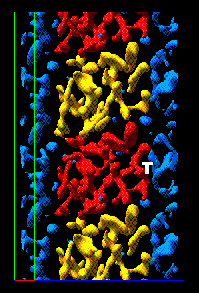

BERKELEY, CA -- Scientists at the Lawrence Berkeley Laboratory (LBL) have produced the first high-resolution three-dimensional image of the site where the anti-cancer drug taxol interacts with vital cell proteins. This could be a major step towards the design of alternative versions of taxol with even greater therapeutic value.
Taxol is a natural substance found only in the bark of the Pacific yew tree (the name "taxol" has been trademarked by Bristol-Myers-Squibb). Chemically synthesized last year, taxol has been shown in clinical tests to be an effective treatment for a number of cancers including ovarian, breast, and lung. According to experts, however, an even more potent anti-cancer drug could be designed if scientists had sufficient structural knowledge of the interactions of the taxol molecule with its target at the atomic level.

LBL researchers have been using electron crystallography to produce three-dimensional images of a protein called tubulin at near atomic-scale resolution. Tubulin is the major constituent of microtubules which are hollow cylinders, like tiny drinking straws, that serve as part of the skeletal system for cells and are crucial to a number of vital functions including mitosis (cell division). The LBL images have revealed the site where taxol binds to tubulin and prevents the protein from performing its necessary tasks.
The research team was led by Kenneth Downing, Eva Nogales and Sharon Wolf, all biophysicists with LBL's Life Sciences Division. The team also included Israr Khan and Richard Luduena, from the University of Texas in San Antonio. The work was reported in the June 1 issue of the journal Nature.
For a cell to divide, the microtubule skeleton that gives it shape must first disassemble, then reform into spindles across which duplicate sets of DNA material line up, and finally disassemble once more and reform into skeletal systems for the two new cells. The extreme flexibility of the tubulin protein enables microtubules to shift through these various formations.
"Taxol is a mitotic stabilizer," says Downing. "When taxol binds to tubulin, the protein loses its flexibility and the microtubules can no longer disassemble."
Other studies have shown that taxol binds only to tubulin that has been polymerized into chains of protofilaments, not to free proteins. The LBL images indicate that taxol attaches itself at the junction where tubulin protofilaments are linked, affecting their interaction and locking them into a fixed position.
"This is the first time that a taxol binding site has been visualized in the tubulin molecule," says Nogales. "Although many questions remain unanswered, a number of biological properties can now be interpreted in terms of our structural reults."
With the latest refinements of their imaging technique and the collection of additional images, the researchers are certain they will be able to construct an atomic model of tubulin and the taxol binding site. Such a model should then enable drug companies to design new and improved versions of taxol.
"We are at the stage now where we feel it is just a matter of collecting and processing enough data to be able to construct an atomic model of the taxol binding site," says Downing.
To produce their images, Downing, Nogales, and Wolf polymerize their tubulin proteins in the same conditions under which microtubules are formed except that the researchers add zinc. The presence of zinc prevents the protofilaments of tubulin from curling around into a closed cylinder. Instead, the polymerized tubulin forms two-dimensional crystalline sheets that are ideal for imaging by electron crystallography. These sheets are then embedded in a mixture of tannic acid and sugar to preserve them during observation and to increase the resolution of the image.
The images were generated on an electron microscope that is equipped with a special "cold stage" that reduces damage to the crystals from the electron beam and yields a less "noisy" image than a conventional electron microscope. The specially equipped microscope also allows samples to be tilted at various angles so images can be recorded from different directions.
"Our group has produced projection maps of these two-dimensional tubulin sheets with a resolution of 3.5 angstroms, compared to a resolution of about 15 angstroms for images of microtubules," Downing says. "With enough two-dimensional images of sheets taken at different angles, we've been able to reconstruct three-dimensional images at a resolution of about 6.5 angstroms."
LBL is a U.S. Department of Energy national laboratory located in Berkeley, California. It conducts unclassified scientific research and is managed by the University of California.